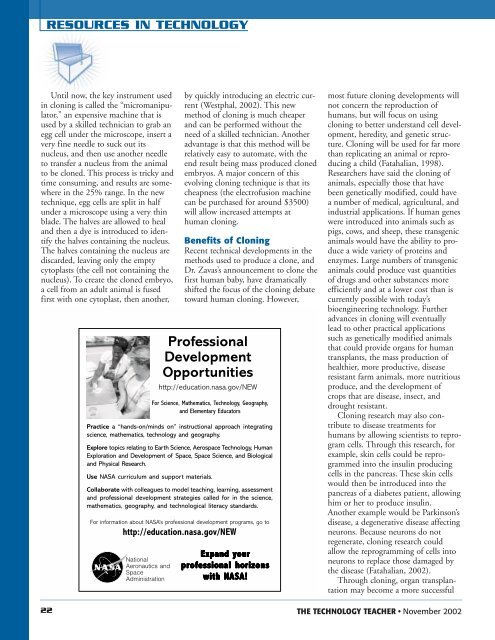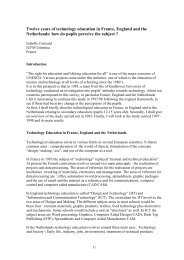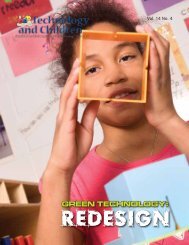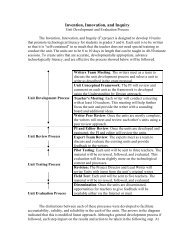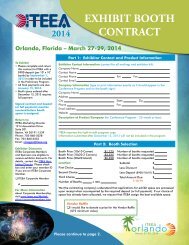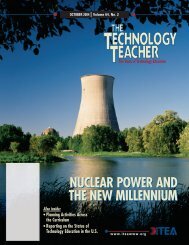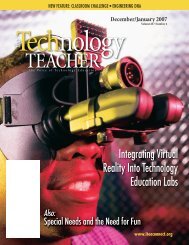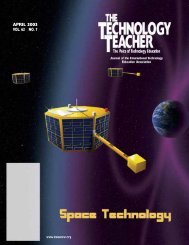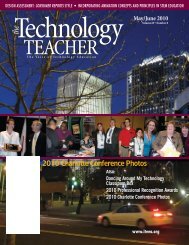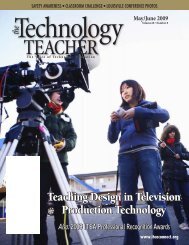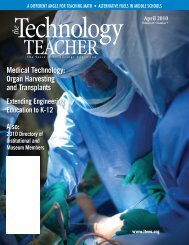RESOURCES IN TECH<strong>NO</strong>LOGYUntil now, the key instrument usedin cloning is called the “micromanipulator,”an expensive machine that isused by a skilled technician to grab anegg cell under the microscope, insert avery fine needle to suck out itsnucleus, <strong>and</strong> then use another needleto transfer a nucleus from the animalto be cloned. This process is tricky <strong>and</strong>time consuming, <strong>and</strong> results are somewherein the 25% range. In the newtechnique, egg cells are split in halfunder a microscope using a very thinblade. The halves are allowed to heal<strong>and</strong> then a dye is introduced to identifythe halves containing the nucleus.The halves containing the nucleus arediscarded, leaving only the emptycytoplasts (the cell not containing thenucleus). To create the cloned embryo,a cell from an adult animal is fusedfirst with one cytoplast, then another,by quickly introducing an electric current(Westphal, <strong>2002</strong>). This newmethod of cloning is much cheaper<strong>and</strong> can be performed without theneed of a skilled technician. Anotheradvantage is that this method will berelatively easy to automate, with theend result being mass produced clonedembryos. A major concern of thisevolving cloning technique is that itscheapness (the electrofusion machinecan be purchased for around $3500)will allow increased attempts athuman cloning.Benefits of CloningRecent technical developments in themethods used to produce a clone, <strong>and</strong>Dr. Zavas’s announcement to clone thefirst human baby, have dramaticallyshifted the focus of the cloning debatetoward human cloning. However,ProfessionalDevelopmentOpportunitieshttp://education.nasa.gov/NEWPractice a “h<strong>and</strong>s-on/minds on” instructional approach integratingscience, mathematics, technology <strong>and</strong> geography.Explore topics relating to Earth Science, Aerospace <strong>Technology</strong>, HumanExploration <strong>and</strong> Development of Space, Space Science, <strong>and</strong> Biological<strong>and</strong> Physical Research.Use NASA curriculum <strong>and</strong> support materials.Collaborate with colleagues to model teaching, learning, assessment<strong>and</strong> professional development strategies called for in the science,mathematics, geography, <strong>and</strong> technological literacy st<strong>and</strong>ards.For information about NASA’s professional development programs, go toNationalAeronautics <strong>and</strong>SpaceAdministrationFor Science, Mathematics, <strong>Technology</strong>, Geography,<strong>and</strong> Elementary Educatorshttp://education.nasa.gov/NEWExp<strong>and</strong> yourprofofessional horizonsonswith NASA!most future cloning developments willnot concern the reproduction ofhumans, but will focus on usingcloning to better underst<strong>and</strong> cell development,heredity, <strong>and</strong> genetic structure.Cloning will be used for far morethan replicating an animal or reproducinga child (Fatahalian, 1998).Researchers have said the cloning ofanimals, especially those that havebeen genetically modified, could havea number of medical, agricultural, <strong>and</strong>industrial applications. If human geneswere introduced into animals such aspigs, cows, <strong>and</strong> sheep, these transgenicanimals would have the ability to producea wide variety of proteins <strong>and</strong>enzymes. Large numbers of transgenicanimals could produce vast quantitiesof drugs <strong>and</strong> other substances moreefficiently <strong>and</strong> at a lower cost than iscurrently possible with today’sbioengineering technology. Furtheradvances in cloning will eventuallylead to other practical applicationssuch as genetically modified animalsthat could provide organs for humantransplants, the mass production ofhealthier, more productive, diseaseresistant farm animals, more nutritiousproduce, <strong>and</strong> the development ofcrops that are disease, insect, <strong>and</strong>drought resistant.Cloning research may also contributeto disease treatments forhumans by allowing scientists to reprogramcells. Through this research, forexample, skin cells could be reprogrammedinto the insulin producingcells in the pancreas. These skin cellswould then be introduced into thepancreas of a diabetes patient, allowinghim or her to produce insulin.Another example would be Parkinson’sdisease, a degenerative disease affectingneurons. Because neurons do notregenerate, cloning research couldallow the reprogramming of cells intoneurons to replace those damaged bythe disease (Fatahalian, <strong>2002</strong>).Through cloning, organ transplantationmay become a more successful22THE TECH<strong>NO</strong>LOGY TEACHER • November <strong>2002</strong>
RESOURCES IN TECH<strong>NO</strong>LOGYprocess. The chronic shortage oforgans means that only a fraction ofpatients who could benefit actuallyreceive transplants, <strong>and</strong> issues ofrejection mean the recipient is forcedinto a regime of drug taking to combatforeign body tissue rejection.Genetically modified pigs are beingdeveloped as an alternative source oforgans by a number of companies(Roslin, <strong>2002</strong>). Transplanting organsfrom one species to another is calledxenotransplantation, <strong>and</strong> throughnuclear transfer, transgenic animalscould be produced that create humanproteins on their cell surfaces, therebyreducing the risk of rejection duringxenotransplantation.There are also a number of practicalapplications for the cloning ofhumans. Infertile couples not wishingto adopt could use cloning to havechildren who are biologically related tothem. Cloning could also be used toproduce offspring free of certain diseases;a fertilized ovum could becloned <strong>and</strong> the duplicate tested fordisease <strong>and</strong>/or genetic defects. If theclone were free from defects, then theother would be as well <strong>and</strong> could beimplanted in the womb. In in-vitrofertilization, a doctor often implantsmany fertilized ova into a women’suterus, counting on one resulting pregnancy.Some women, however, canonly supply one egg. Using cloning,that one egg could be turned intoeight, dramatically increasing thechances for a viable pregnancy(Fatahalian, 1998). It is also hopedthat one day, through cell cloningtherapies, many diseases can betreated, <strong>and</strong> even organ regenerationmay be achieved through thereprogramming of a patient’s owncells, alleviating the necessity tocreate <strong>and</strong> destroy human embryos.As the field of biotechnologyexp<strong>and</strong>s, so do the possibilities <strong>and</strong>ethical responsibilities.Societal <strong>and</strong> Ethical ConcernsMany ethical, moral, <strong>and</strong> religiousconcerns have arisen over the potentialapplications of the cloning technology.The technology is still in its infancy<strong>and</strong>, in the meantime, society as awhole has time to contemplate whichuses of the technology might beacceptable <strong>and</strong> which are not. It isimpossible to predict all potentialapplications of a new technology. Mostwill be beneficial, but all technologycan be used in one way or another.The solution is not to regulate thetechnology itself, but how it is applied(Roslin, <strong>2002</strong>). The ethical debate overcloning also encompasses the possiblepsychological impact on a cloned offspring.Will a human clone tend tohave a diminished sense of individuality?Will there be societal stigmatizationor discrimination due to anindividual’s genetic differences? Ethicalquestions will arise as to the effect ofhuman clones on parenting <strong>and</strong> familylife. Will the parents of clones valuetheir children according to how closelythey met preordained specifications? Achild born from an adult DNAcloning would be considered a delayedidentical twin of that parent. It isunknown as to how a human mightreact knowing they were an exactduplicate of an older individual.Cloning, therefore, could underminebasic elements of a loving, nurturingfamily, such as the acceptance of eachchild as a unique individual(Worldbook, <strong>2002</strong>).There are many other concerns thatmust be dealt with, such as society’suse of cloning for eugenic purposes.Cloning combined with genetic engineeringcould lead to selectivebreeding—perhaps a clone with aboveaverage strength <strong>and</strong> below averageintelligence leading to a new geneticunderclass. Would the development ofclones specifically designed for warfareor slavery be acceptable? Fairness inaccess to the technology of cloning isalso an issue. Will there be majorworldwide inequities? How willthese technologies affect developingnations <strong>and</strong> their dependence ontechnologically advanced nations?Answering these questions <strong>and</strong> themany more that are sure to beraised will not be easy <strong>and</strong>, unlesswe endeavor to develop a technologicallyliterate society, will not beanswered wisely.Arguments For <strong>and</strong> AgainstCloningSupporters of cloning feel that, withthe careful continuation of research,the technological benefits of cloningfar outweigh the possible social consequences,while those in opposition tocloning consider it as much a moralproblem as a technical one. Thoseopposed are concerned that scientistsare “playing God” <strong>and</strong> interfering withthe natural process. Some of the argumentsagainst cloning are that it mightlead to the creation of genetically engineeredgroups of people for specificpurposes, such as warfare or slavery.Opponents are concerned that cloningcould result in additional defects in thehuman gene pool, <strong>and</strong> feel that thereare too many unknown factors thatcould adversely affect human clones.Besides their concern for the individualrights of a clone, there are fearsthat they might have a diminishedsense of self. Religious groups putarguments forth that cloning is againstGod’s will, <strong>and</strong> that it will further corruptthe traditional concept <strong>and</strong> valuesof the family. The fear that humanclones might be bred strictly as asource of organs for organ transplantsis a powerful argument used todevelop support against the pursuit ofhuman cloning. But for every argumentput forth against human cloningthere is an equally persuasive one indefense of it. Cloning would enableinfertile couples to have children oftheir own. Couples who are at risk ofproducing a child with a geneticdefect would have the opportunity ofNovember <strong>2002</strong> • THE TECH<strong>NO</strong>LOGY TEACHER 23


